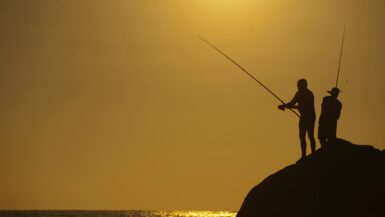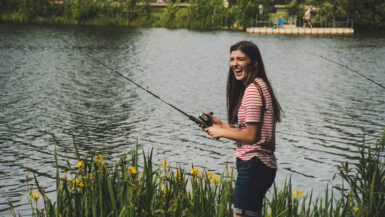Fishing for smallmouth bass in freshwater can be an enjoyable, rewarding experience. Many anglers have found success when fishing for smallmouth bass in rivers, lakes, and streams. With the right technique and some simple tips, you can easily have a successful trip. In this article, we’ll share some tips and techniques for catching smallmouth bass that will help you maximize your time fishing for them. Read on to learn more about the best lures, tactics, and techniques for catching smallmouth bass.
Types of Fishing Gear
Knowing the types of essential fishing gear that you need when fishing for smallmouth bass is an important part of the process. There are a wide range of types of essential fishing gear that you should consider when you’re fishing for smallmouth bass in freshwater.
Rod and Reel Combo
The ideal rod-and-reel combo when fishing the smallmouth bass is a spinning rod and reel. A spinning rod-and-reel combo is beneficial because it is designed to feel lighter and easier to operate than other rod and reel combos. Some of the most popular combos for smallmouth bass are an 8-foot, medium-light spinning rod with a medium-light spinning reel.
Lures and Baits
There are many types of lures and baits that you can use when fishing for the smallmouth bass. Some of the most common lures and baits used for smallmouth bass are crankbaits, spinnerbaits, soft plastics, jigs, and live bait. Using a combination of these different lures and baits can help increase your success when fishing for the smallmouth bass.
Line, Leaders, and Terminal Tackle
Using the correct line, leaders, and terminal tackle is essential when you’re fishing for smallmouth bass. Monofilament line is the most common type of line to use when fishing for smallmouth bass. Leader material such as fluorocarbon can help in tough fishing conditions. Terminal tackle such as hooks, swivels, and sinkers can help you to effectively fish for smallmouth bass.
Other Essential Gear
Other pieces of essential gear that you should have when fishing for smallmouth bass include a quality tackle box, a fish finder, a net, and a landing net. A tackle box will allow you to easily organize and store your lures and baits. A fish finder can be used to identify areas that may contain smallmouth bass. A net and a landing net are useful when you’re trying to land a fish.
When fishing for smallmouth bass in freshwater, having the right types of essential fishing gear will help increase your chances of success. Knowing the types of essential fishing gear that you need and why it is important will help you be more successful when fishing for smallmouth bass.
The Importance of Location
When it comes to fishing for smallmouth bass in freshwater, the location you choose is of utmost importance. Smallmouth bass prefer warm and shallow water. Therefore, finding an area that is close to a creek, river, or lake with these conditions will increase your chances of success. Look for areas that are surrounded by plenty of vegetation or rocks, as smallmouth bass enjoy hiding in and around these areas. If possible, try to find a spot that has a current, as it will help to attract the fish in the area.
Identifying Smallmouth Bass Habitats
In addition to choosing the right location, it is also important to identify smallmouth bass habitats. Look for areas that have structure such as logs, rocks, and vegetation. Smallmouth bass also tend to stay within a certain depth range, so it is important to keep that in mind when selecting a location. Additionally, look for areas where water temperature is warmer, as smallmouth bass prefer water that is between 60-80 degrees Fahrenheit.
Bait Selection
Once you have identified an area with the right conditions, bait selection is another key factor to consider. Smallmouth bass feed on a wide variety of bait, so it is important to understand their feeding habits. Live bait such as minnows, crayfish, and worms are the most popular and often the most effective when it comes to catching smallmouth bass. Artificial lures such as spinnerbaits, crankbaits, and jigs are also effective for targeting smallmouth bass in freshwater. Be sure to select the right type of bait or lure based on the conditions in the area.
Importance of Timing
Finally, timing is an essential component of fishing for smallmouth bass in freshwater. Smallmouth bass tend to feed most actively during the early morning and late evening, so try to plan your trips accordingly. Also, pay attention to seasonal changes and be sure to select baits and lures that are appropriate for each season. All of these factors, combined with the right location and bait selection, can help you increase your chances of success when it comes to fishing for smallmouth bass in freshwater.
Timing and Tides
Fishing for smallmouth bass can be an enjoyable and rewarding experience, but timing is key. Depending on the season, the best times to fish for smallmouth bass can vary. During the warmer months, when the water is more active, the best times to fish are in the early morning and late afternoon when the sun isn’t high in the sky. The cooler months offer more flexibility, as the water temperature is lower, allowing anglers to catch bass during the day when the water is still warm.
Factors Affecting Smallmouth Bass Fishing
Several factors can influence the best times to fish for smallmouth bass. Wind, water temperature, river level, and moon phases can all affect the activity of bass. Wind can cause the temperature to fluctuate, as well as affect the amount of light that reaches the water. Water temperature is one of the most important factors in bass fishing, and higher temperatures can result in more activity. River levels and moon phases can also influence the best times to fish for smallmouth bass, as higher water and brighter moons will result in more activity.
Effects of Tides on Smallmouth Bass Fishing
Tides can also play a role in smallmouth bass fishing. During low tides, bass will move away from shallow, grassy areas and into deeper pools where they can find food and shelter. During high tides, bass will move back into shallow flats and grassy areas to feed. This is an ideal time for anglers, as the bass are actively feeding and more easily caught. Anglers should look for moving water and structure, such as rocks, logs, or points, to increase their chances of catching a smallmouth bass.
Using Fishing Technology to Find Smallmouth Bass
Modern technology can also be used to help anglers find smallmouth bass. Fish finders are a great tool for locating structure, and can be used to locate bass in deeper water. Anglers can also use lures equipped with sonar transducers to detect bass activity in shallow water. This technology can help anglers locate bass in areas they may not have thought to look in.
Conclusion
Timing and tides can be key factors in fishing for smallmouth bass. By understanding the best times of day to fish and taking into account factors like wind, water temperature, river level, and moon phases, anglers can increase their chances of a successful smallmouth bass fishing outing. Additionally, using modern fishing technology can help anglers locate bass and structure more easily. With the right knowledge and expertise, anglers can have an enjoyable time fishing for smallmouth bass.
Techniques for Catching Smallmouth Bass
If you want to increase your chances of catching smallmouth bass when fishing in freshwater, it is important to locate the right spot. Smallmouth bass are usually found in relatively shallow waters around structures such as rocks, weeds, points and fallen logs. Staying near the shoreline, you can cast and retrieve lures such as crankbaits, jerk baits, spinners, and soft plastics on jigheads that are designed to mimic a small fish or an insect.
Optimal Time of Day for Catching Smallmouth Bass
Smallmouth bass tend to be most active during the cooler times of the day like early morning and late evening. They can also be caught during the midday hours but you should focus your efforts during the cooler temperatures. When wanting to catch smallmouth bass during the early morning, casting or trolling a crankbait is a great technique. It’s a good idea to start near the shoreline and gradually move out. During the late evening they are usually more active near the shallows where they inhabit.
Understanding the Behavioral Habits of Smallmouth Bass
When fishing for smallmouth bass, it is important to understand the behavioral habits. Smallmouth bass like to feed on small fish, crawfish and insects. When selecting lures and bait, it is important to pick ones that mimic these items. When using live bait, nightcrawlers and minnows are two of the most popular choices. Smallmouth bass are most active during the summer months and can be caught in waters ranging from 65-75 degrees.
Tips to Improve Your Chances of Catching Smallmouth Bass
When fishing for smallmouth bass, there are a few tips that can help you increase your chances of catching them. First, fish slow and use a light line. Be sure to use smaller lures or baits that imitate the food they naturally feed on. It’s also important to pay attention to the temperature of the water and the cover, as these factors can be crucial for catching smallmouth bass. Finally, experiment with different techniques and depths until you find what works best.
Live Bait vs. Artificial Lures
Using live bait is a great option when fishing for smallmouth bass in freshwater. Live bait is the most natural form of bait available and is often the best choice when smallmouth bass are feeding. Live bait can also be very effective in catching smallmouth bass because it is soft and attracts the attention of the fish. Live bait is also effective in areas where artificial lures can be easily seen or heard. Live bait is often a good choice for smallmouth bass anglers because of its availability, affordability, and effectiveness.
However, live bait can have some drawbacks. Live bait is often more expensive than artificial lures, and can be messy and smelly. Live bait can also be difficult to transport and store, and is more time consuming to rig up than artificial lures. Another disadvantage is that fish can become accustomed to the same type of live bait, and may become less likely to strike in the future.
The Benefits of Artificial Lures
Using artificial lures is another great choice when fishing for smallmouth bass. Artificial lures have many advantages over live bait. Artificial lures are often more durable and come in a wide variety of sizes, shapes and colors, making them ideal for a variety of fishing conditions. Artificial lures are also more discreet than live bait, making it easier to get strikes from smallmouth bass. In addition, artificial lures are often cheaper than live bait and can be easier to transport and store.
However, artificial lures do have some drawbacks. Artificial lures can be more difficult to use than live bait and often require more skill and experience. They also lack the scent and texture of live bait, so they may not be as attractive to smallmouth bass. Additionally, artificial lures can be easily spotted by fish, so they may require more casts to be effective.
Selecting the Right Lure for Smallmouth Bass
Regardless of whether you choose to use live bait or artificial lures, the key to catching smallmouth bass is to choose the right bait for the water you are fishing. Whether you choose live bait or artificial lures, consider the type of water, the size of the bass, and the type of cover being used before making a selection. Researching the area you are fishing, talking with local anglers, and experimenting are all great ways to find the right bait for smallmouth bass.
Important Safety Tips
When fishing for smallmouth bass, the most important thing is to stay safe. Here are a few tips to help you stay safe while fishing for smallmouth bass in freshwater:
Wear a Life Jacket
Always wear a life jacket when fishing for smallmouth bass in freshwater. It’s important to stay safe and remain visible in the water. It’s also important to be aware of the current, wave patterns, and other environmental conditions.
Check the Weather
Before heading out on the water to fish for smallmouth bass, be sure to always check the weather. This will help you to know what kind of conditions you will be facing while fishing and will also help you plan accordingly. Be sure to also check the safety regulations in the area, including any local boating laws.
Know Your Limits
It is important to know your own limits when fishing for smallmouth bass in freshwater. Know when to take a break and when to call it a day. Make sure you stay hydrated and wear sun protection if you plan to be out for an extended period of time.
Bring a Buddy
If possible, bring a buddy with you when fishing for smallmouth bass in freshwater. This way, you have a second set of eyes to help spot fish, as well as an extra pair of hands to help land larger fish. Plus, it’s always more fun to fish with a friend!
Have the Right Gear
When fishing for smallmouth bass, make sure to have the right gear. Make sure to have the right rods, reels, and lures for the conditions you plan to face. Having the right gear can help you land bigger fish and have a more successful fishing trip.
By following these safety tips, you can ensure that you have a fun and safe time when fishing for smallmouth bass in freshwater.
The Benefits of Fishing for Smallmouth Bass
Fishing for smallmouth bass in freshwater can be an enjoyable experience, especially when the right techniques and tips are used. Learning the habits of the fish and the terrain of the body of water is important for successfully catching smallmouth bass. Once the right bait has been chosen, and a few other techniques are adhered to, anglers are sure to enjoy a successful day of fishing. Familiarizing oneself with the local regulations and other details about the fish before heading out can help make the experience even better. From consuming the fish to simply enjoying the feel of being out in nature, fishing can be a rewarding activity for any outdoor enthusiast.





Leave a reply